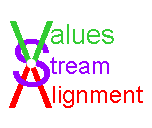Shingo PrizeDid you ever have one of those chance encounters with an individual that makes you sit down and really think about what just happened? It happened to me recently.
Our Neurological Institute has a “go to gemba” process where each of our administrators spend at least a week each quarter, making daily rounds in our in-patient unit to talk with patients and determine if we are meeting their expectations for care. I have found the interaction with our patients some of the most gratifying work that I’ve done while working at the Clinic.
Last week, while connecting with our patients, I had a chance encounter with a very interesting man. He took the time to let me know where we had fallen short in our care of a loved one. He was not upset or angry, he felt the need to share his experience and I seemed open to listening, so we talked.
As we continued our conversation, a familiar language started to emerge and I found myself actively engaged in a discussion of root cause, errors, defects, visual management, standard work, etc. We were talking lean.
“I work with dairy farmers,” he said. “I focus on preventing the diseases that you detect and fix.” We continued for a little while until he had to leave. I told him I would be back in the morning. He handed me his business card and I saw his Guiding Principle – “In Pursuit of Parlor Perfection for healthy, comfortable, well fed, pregnant cows.”
Being a student of lean, I recognized the principle of “Pursuit of Perfection” and wanted to learn more about how this principle has been applied in the dairy business. Over the next two days, we spent a total of nearly three hours discussing the opportunities he saw for us to improve our patient care processes and he shared with me the details of his consulting business where he helps dairy farmers focus on quality at the source and increase milk production through the reduction of disease.
Without a college degree or a lean certification or any formal lean training, he has mastered the application of lean principles, systems and tools as described in the Shingo Prize for Operational Excellence.
His simple philosophy – listen to the cows.
He told me about how milking parlors are built for the efficiency of the farmer; however, their design results in decreased milk production from the cows (workers). Automation and technology take the farmer away from the cows and is creating a whole host of quality problems – from diseases, passed on through their milk and beef to humans, to increased costs due to inefficient milk collection techniques that cause cows to produce less milk.
We talked about the backwards way our current health care system places its emphasis on treating diseases, rather than preventing them. He told me about his application of lean principles such as lead with humility, respect for every “cow”, flow, scientific thinking, constancy of purpose, systems thinking, and value for the customer.
My head was spinning. I was drawing parallels with the tools of lean such as visual management, standard work, quick changeover, error-proofing, preventive maintenance, etc. Could the humble cow be the start of the Healthcare value stream?
I’ve made the transition from manufacturing to healthcare and have seen how the principles of lean apply across multiple, diverse industries, including lean dentists and lean government. This was the first time I was really exposed to the potential of lean – at the source – in the supply chain of the food and farming industries – before the production or processing stages – and recognized the connection to the healthcare industry – a strange customer of the current food processing business.
We traded contact information and vowed to continue our discussion. We’ve asked him to serve on our Patient Advisory Council and he’s asked me to help spread his message on disease prevention. It sounds like a good deal so far.
As my father once told me, “The more you know, the more you find out you don’t know”. I learned a lot last week and recognize that I have a lot more to learn.




